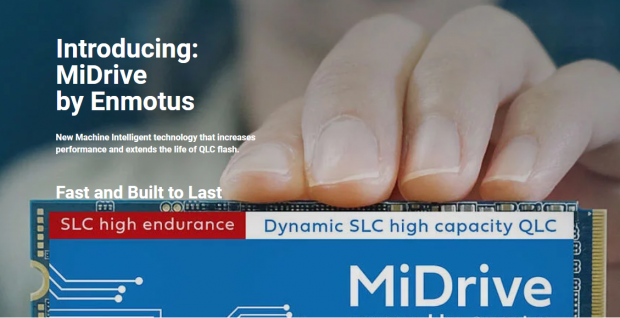CES 2020 - Phison and Enmotus announce their new MiDrive SSDs that combine low-cost QLC and high-speed SLC flash memory on the same drive.
The new MiDrive SSDs feature two types of memory on the same drive: quad-layer cell (QLC), which has higher capacities and is more cost-effective for OEMs, and speedier single-layer cell (SLC) flash on a single NVMe drive. Enmotus' unique machine-learning MiDrive technology automatically segregates most-used data and games and stores them on the faster SLC memory, whereas the bulk of the data is stored on the QLC portion.
"MiDrive blends high endurance, high performance static SLC plus QLC on a single controller architecture NVMe SSD," reads the announcement. Phison notes this solution will help maintain SSD endurance by reducing read/write frequency.
It's also worth noting that Enmotus is the same company who made AMD's StoreMI tech, which allows users to combine multiple drives to hit HDD capacities with SSD-like speeds.
Machine Intelligent Technology Breaks The Mold Of Traditional SSD Architectures
MiDrive has taken a quantum leap in SSD architectue. As the industry strives to squeeze more endurance and performance from Quad Level NAND (QLC), Enmotus blends high performance SLC NAND with QLC on a single controller NVMe SSD and uses sophisticated Machine Intelligent Algorithms to manage QLC's limitations.
A Better Way Of Managing Your Data
Leapfrogging traditional caching and dynamic SLC caching techniques, Enmotus has come to market with a highly intelligent managed QLC based solution. This provides the best of performance AND capacity without sacrificing cost or using exotic flash technology. Simple, high endurnace 30,000+ P/E flash is combined with lower endurance QLC within a single M.2 device and managed by a machine intelligent software layer.
Minimizing Write Amplification
The Enmotus high endurance SSDs do exactly that. Traditional caching technologies exacerbate write amplification, resulting in additional writes to the QLC beyond the data that is actually written. MiDrive's machine intelligence results in not only a higher performing solution, but also longevity. SSDs wear out - it's a fact of life. However, intelligence can mitigate the risk of premature wear out failure by ensuring that all the heavy traffic goes consistently for frequently accessed data to high endurance media.
New Possibilities
MiDrive opens new markets for QLC beyond primarily read intensive applications.
The increased endurance and performance of SLC make it ideal for Thin and Lite
notebooks running business applications as well as gaming and video applications
"Phison worked closely with Enmotus integrating Enmotus' technology with our controllers," said K.S Pua, CEO of Phison Electronics. "Positioning MiDrive between the niche high performance consumer SSD market and cost conscious users presents a tremendous market opportunity for Phison and Enmotus," added K.S.
"MiDrive addresses not only the performance and endurance challenges of QLC, but future technologies as well. As flash manufacturers race to achieve price parity with hard drives, the endurance of next generation flash technology such as Penta or five layer flash is expected to get worse," said Andy Mills, CEO of Enmotus.
"The Machine Intelligence behind MiDrive solves this problem by enabling QLC and beyond to be deployed in applications without compromising warranty or longevity specs," continued Mills.



